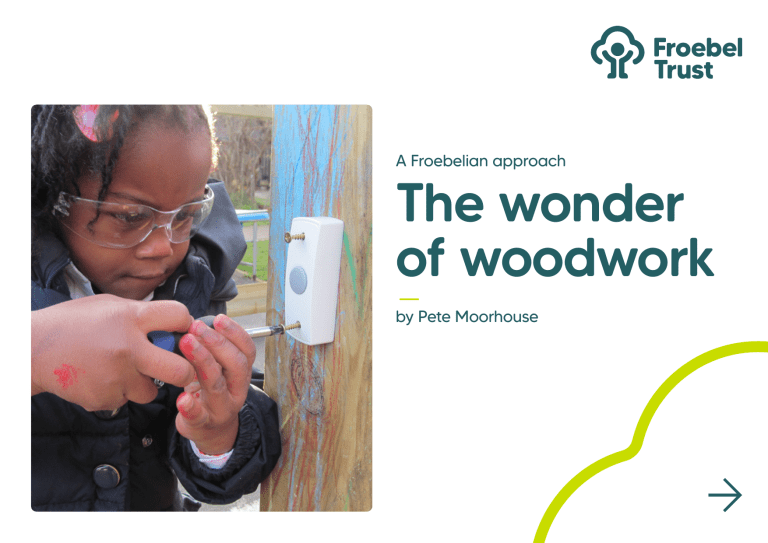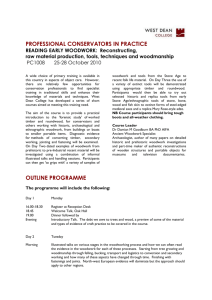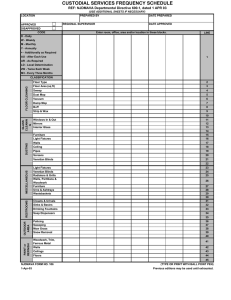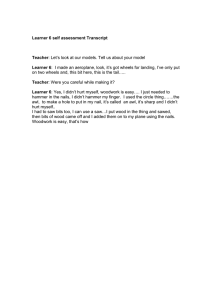
A Froebelian approach The wonder of woodwork — by Pete Moorhouse Froebelian principles Introduction The occupation of woodwork The value of woodwork Organising your woodwork area The role of the adult Risks and health and safety Final thoughts Contact Contents Froebelian principles This is an interactive document Introduction The top toolbar and contents buttons allow you to navigate through the different sections of the guide. The occupation of woodwork The value of woodwork Organising your woodwork area The role of the adult Risks and health and safety Final thoughts Contact Froebelian principles Introduction The occupation of woodwork The value of woodwork Organising your woodwork area The role of the adult Risks and health and safety Final thoughts Contact Froebelian principles Friedrich Froebel (1782–1852) was the inventor of kindergartens and a pioneer of early childhood education and care. Froebel’s work and writing changed the way we think about and value early childhood. Froebel’s ideas were considered revolutionary in the 1850s. The principles of his work continue to challenge and be relevant to modern mainstream early years educational practice. Froebel Trust Unity and connectedness Autonomous learners Everything in the universe is connected. The more one is aware of this unity, the deeper the understanding of oneself, others, nature and the wider world. Children are whole beings whose thoughts, feelings and actions are interrelated. Young children learn in a holistic way and learning should never be compartmentalised for everything links. Each child is unique and what children can do rather than what they cannot, is the starting point for a child’s learning. Children learn best by doing things for themselves and from becoming more aware of their own learning. Froebelian educators respect children for who they are and value them for their efforts. Helping children to reflect is a key feature of a Froebelian education. The value of childhood in its own right Childhood is not merely a preparation for the next stage in learning. Learning begins at birth and continues throughout life. Relationships matter The relationships of every child with themselves, their parents, carers, family and wider community are valued. Relationships are of central importance in a child’s life. 1 Froebelian principles Introduction The occupation of woodwork The value of woodwork Organising your woodwork area The role of the adult Risks and health and safety Creativity and the power of symbols The central importance of play Knowledgeable and nurturing educators Creativity is about children representing their own ideas in their own way, supported by a nurturing environment and people. As children begin to use and make symbols they express their inner thoughts and ideas and make meaning. Over time, literal reflections of everyday life, community and culture become more abstract and nuanced. Play is part of being human and helps children to relate their inner worlds of feelings, ideas and lived experiences taking them to new levels of thinking, feeling, imagining and creating and is a resource for the future. Children have ownership of their play. Froebelian education values the contribution of adults offering ‘freedom with guidance’ to enrich play as a learning context. Early childhood educators who engage in their own learning and believe in principled and reflective practice are a key aspect of a Froebelian approach. Froebelian educators facilitate and guide, rather than instruct. They provide rich real life experiences and observe children carefully, supporting and extending their interests through ‘freedom with guidance’. Engaging with nature Find out more about a Froebelian approach to early childhood education at froebel.org.uk Final thoughts Contact Experience and understanding of nature and our place in it, is an essential aspect of Froebelian practice. Through real life experiences, children learn about the interrelationship of all living things. This helps them to think about the bigger questions of the environment, sustainability and climate change. Froebel Trust 2 Froebelian principles Introduction The occupation of woodwork The value of woodwork Organising your woodwork area The role of the adult Risks and health and safety Final thoughts Contact Introduction Learning through doing The ‘occupation’ of woodwork encompasses core Froebelian principles embracing the holistic nature of the development of children. For Froebel, play and creativity are central integrating elements. The experiential nature of woodwork involves the ‘whole’ child developing core dispositions and especially nurturing wellbeing, self-confidence, and a sense of agency – that ‘can-do’ spirit that develops as ideas are put into action. Froebel Trust There is something special about woodwork’s ability to engage young children. It is learning through doing. The smell and feel of wood, using real tools, working with a natural material, the sounds of hammering and sawing, hands, body and minds working together to express imagination and solve problems, the use of strength and coordination: all go together to captivate young children’s interest. High levels of sustained engagement and enjoyment are commonplace. It provides a truly unique experience. 3 Froebelian principles Introduction The occupation of woodwork Creative and critical thinking skills are central to woodwork, both in terms of self-expression and problem-solving – as children make choices, find solutions, learn through trial and error and reflect on work. Children develop learning at their own pace and once they have mastered basic skills, they start to explore possibilities and express their imagination. Woodwork provides rich, multi-layered experiences with many The value of woodwork Organising your woodwork area The role of the adult Risks and health and safety Contact opportunities to build on previous learning. The knowledge and skills gained can resonate throughout life. Children delight in the nature and beauty of wood and in what tools enable our hands to do. Froebel valued experiential play and learning through connection with natural materials and nature, which he saw as both being nurturing for the soul and essential for development. Fig. 2: Children gain confidence in mastering new skills “To learn a thing in life and through doing is much more developing, cultivating and strengthening than to learn it merely through the verbal communication of ideas.” Fig. 1: Children show sustained engagement at the workbench Froebel Trust Final thoughts Fig. 3: Discovering cause and effect – learning through doing We observe children working with their hands, constructing and creating, their work slowly taking shape. It’s easy to marvel at what children create but woodwork is not really about what children make, the real transformation is within the child. Froebel 1885: 279 4 Froebelian principles Introduction The occupation of woodwork The value of woodwork Organising your woodwork area The role of the adult Risks and health and safety Final thoughts Contact The occupation of woodwork Wood, along with clay and stone, has been used throughout history by humans in a vast number of applications and is deep-rooted in the heritage of all cultures. Working with wood also has a long tradition in education, now for over 200 years. Froebel co-led a school in Keilhau, Germany, for children from the age of seven before founding his kindergarten. He provided woodwork there and involved the pupils in real projects around the school, a tradition which continues today. Froebel had a natural affinity with wood. Perhaps growing up in the rural countryside of eastern Germany, spending time playing in the woods and his work as a forester all made an impact. Fig. 4: Working with wood has a long tradition in early education (©Early Education) Fig. 5a: Active learning with high levels of concentration and focus “Woodwork is active learning at its best.” Bruce 2004: 109 5 Froebelian principles Introduction The occupation of woodwork The value of woodwork Organising your woodwork area The role of the adult Risks and health and safety Final thoughts Contact Froebel viewed children as holistic learners who learned most effectively by being active with their hands and minds combining imagination and physical movement when exploring their interests. Froebel’s ideas helped inspire the widespread introduction of educational handicraft (known as Sloyd) in Nordic countries, initially started by Uno Cygnaeus in Finland and further developed by Otto Salomon in Sweden (Brehony 1998). From the 1880s many kindergartens around the world started embracing woodwork and it rapidly became adopted as an occupation. Fig. 6: Holistic learning with hands, body and mind working together Fig. 5b: Active learning with high levels of concentration and focus Froebel Trust 6 Froebelian principles Introduction The occupation of woodwork The value of woodwork Organising your woodwork area The role of the adult Risks and health and safety Final thoughts Contact Froebel’s Gifts and Occupations Froebel provided a unique set of ‘Gifts’ for children. Most of these were comprised of sets of three-dimensional wooden blocks that would stimulate curiosity, encourage exploration, and develop spatial thinking. Froebel’s ‘Occupations’ expanded on the Gifts, providing a greater diversity of materials and greater possibilities for exploration. Examples include clay modelling (see the pamphlet on clay in this series), paper folding and needlework (Tovey 2017). This practical work was seen to develop life skills. It allowed children to reconstruct their experiences through play, and move from concrete to more abstract thinking. Unlike the Gifts, the Occupations cannot return to their original forms once they are used giving children a sense of the transformational and expressive potential of material. Froebel Trust Fig. 7: There is a natural progression from the Gifts to woodwork – from wooden block play to constructing with wood children build on knowledge and explore new possibilities 7 Froebelian principles Introduction The occupation of woodwork The value of woodwork Organising your woodwork area The value of woodwork Today, children’s learning is often divided into different areas. In contrast, Froebel regarded children’s learning and development as holistic – everything links. Holistic learning and development Woodwork reflects Froebel’s view. It encompasses all areas of learning and embraces the characteristics of how children learn effectively. It fosters confident, creative children. Playing and exploring Froebel saw children as intrinsically powerful and self-motivated learners, who learn from real-life, practical experiences. He emphasised the process of ‘becoming’ through play. Wood enables children to explore and express their imagination. Initial exploration of wood and the way the tools work leads to various forms of expression, cross-curricular learning and personal development. Froebel Trust The role of the adult Risks and health and safety Final thoughts Contact Creativity nourishes the human soul – it elevates our spirits and transcends the everyday. Froebel believed that humans are essentially creative and productive and fulfilment comes through developing these in harmony with the world. Children can only learn what they are ready for and should have freedom to learn at their own developmental pace. By keeping woodwork open-ended, children naturally gravitate to ways of working that are right for them. For some children this will be exploratory tinkering, schematic repetition or symbolic representation, (abstract or realistic, sculptural or architectural). For others, this may involve pursuing specific ideas or a narrative. Wood and tools ignite interest and curiosity, stimulating children to express their imagination, emotions and thoughts, making the inner outer (Froebel in Lilley 1967). Through the outer process of making, children develop new inner feelings, as they explore ideas, engage in new narratives, ask questions and find solutions, fostering contentment and wellbeing. Fig. 8: Creativity is integral to woodwork. Children express their imagination and ‘think outside the box’ to resolve the challenges they encounter Through woodwork, “all areas of a child’s learning can be integrated into one meaningful activity, a key Froebelian concept.” Tovey 2017: 57 8 Froebelian principles Introduction The occupation of woodwork The value of woodwork Organising your woodwork area The role of the adult Risks and health and safety Solly in Moorhouse 2018:2 Froebel Trust Contact “Play at this time is not trivial, it is highly serious and of deep significance.” Fig. 9: Woodwork throws up many authentic problems to solve. Here, thinking what could be used to represent the feelers on the butterfly – thin wood, string, wire? – before settling on straws. Next, how to best join them securely so they do not move? Initially they were attached with one nail and could still rotate but then, after reflection, another nail was added so that they remained fixed in place “Woodwork is a bit like a magic carpet of skills which last a lifetime. It involves curiosity, creativity and a rich opportunity to engage with process-based learning leading to deep involvement and satisfaction.” Final thoughts Froebel 1885: 55 “Creativity: ideas given visible form” Froebel in Lilley 1967: 47 As children follow their interests, making what they want to make, they create their own problems but have the intrinsic motivation to persevere to find their own solutions and learn from mistakes. In this way, creative and critical thinking skills are central both in terms of design ideas and problem-solving. Wood can provide endless opportunities for creative expression and developing design thinking. Fig. 10: Here sculptural work has been painted Fig. 11: Ideas are given form as children create and express their imagination 9 Froebelian principles Introduction The occupation of woodwork The value of woodwork Organising your woodwork area The role of the adult Risks and health and safety Fig. 12: ‘These can be the arms. How am I going to attach my arms?’ Physical skills and development Hand-eye coordination, increasing manipulative control, and muscular and core-body strength all combine to develop agility and dexterity. “I want to educate people to be free, to think, to take action for themselves.” Personal development Self-activity is a central Froebelian concept. Froebel stressed that children need to be at the centre of their learning so when they make what they want to, they are the protagonists in their explorations. Empowerment comes through being trusted to work with real ergonomic tools. Froebel Trust Children show satisfaction in their mastery of new skills and take immense pride in their creations. This sense of empowerment and achievement provides a visible boost to self-esteem and self-confidence. Togetherness is also an important Froebelian principle. Woodwork can provide opportunities for children to collaborate by working on shared models or longer term projects. Children will be sharing thinking and ideas, negotiating and problem-solving together, developing empathy and respect as they work alongside each other. Final thoughts Contact Developing language and communication skills Children talk about wood as material, discuss their emerging designs and working through problems. Mark-making is involved first in getting design ideas down on paper and then on the wood itself. There is a wide range of books relating to wood that can support literacy and stimulate curiosity. Froebel in Lilley 1967:41 Fig. 13: Children work together to exchange ideas, solve problems, and offer practical help Fig. 14: Children have a natural desire to work with their hands, to construct and build. Putting their ideas into action imparts a ‘can-do’ attitude and imbues children with a strong sense of agency 10 Froebelian principles Introduction The occupation of woodwork The value of woodwork Organising your woodwork area The role of the adult Risks and health and safety Fig. 16: Children learn to handle tools safely and with increasing control Mathematical thinking There are many opportunities to explore numeracy, shape, space and to measure. Various mathematical concepts are involved – matching, classification, counting, measuring, proportion, comparison, size, weight and balance, and two- and three-dimensional shapes. Figs. 15a (top) and 15b (above): Woodwork provides plentiful opportunity for mark-making – here on the wood itself Froebel Trust Final thoughts Contact Fig. 17: Mathematical equipment includes rulers, tape measures, squares, spirit levels etc. “Fine motor skills, such as holding a nail and screwing, and gross motor skills, when children hammer and saw, are developed. Woodwork involves a breadth of movements – pushing/pulling (using saws and files), rotating (screwdriver, drill, wrench, vice) and levering (claw hammer, Japanese nail puller) and rubbing (sandpaper).” Moorhouse 2019 11 Froebelian principles Introduction The occupation of woodwork The value of woodwork Organising your woodwork area The role of the adult Risks and health and safety Final thoughts Contact Making sense of the world Wholeness and connectedness were central to Froebel’s thinking, the concept that everything links. This principle of ‘unity’ was emphasised by attention to ‘opposites’, which can further children’s understanding and help them make sense of the world. With woodwork this will include experiencing the reversible and irreversible; pushing and pulling; connecting and disconnecting; dividing and making whole, and so on. Children experience many scientific and mechanical concepts such as discovering how to lever a nail out or how to get a wheel to rotate on an axle. In this way, woodwork can play a central role in developing Science, Technology, Engineering and Mathematics (STEM) by making direct connections between different areas of learning. Children can discover the value in making and repairing through working with their hands. Froebel Trust Fig. 18: With woodwork, learning is authentic and meaningful and can link to made objects in the wider world. Learning can build naturally on children’s interests and make connections with previous knowledge and experience 12 Froebelian principles Introduction The occupation of woodwork The value of woodwork Organising your woodwork area The role of the adult Risks and health and safety Final thoughts Contact Sustainability Woodwork helps counteract the current culture of “consume and dispose” by developing an understanding of the value of making and repairing. Children also discover how they can re-purpose materials, by making models from a selection of recycled materials. Understanding where wood comes from, seeing the beauty of wood and how long trees take to grow can develop respect for the value of wood and the need for us to take responsibility for our shared environment. Planting trees with the children can further support this. Figs. 19a and 19b: Zahid added wheels to his block. Initially he was disappointed as the wheels did not touch the floor. Back at the workbench he reflected on this for some time. He removed the wheels and positioned them lower – he rushed to the floor to test the car again – this time the wheels touched – but now he discovered that they did not rotate. He tried resolve the problem, and this time, with some sensitive adult interaction using open ended questions, Zahid worked out that they were ‘too fixed’ and he needed to loosen the wheels. His satisfaction was plainly visible in seeing the rotating wheels. ‘They’re turning!’ Fig. 20: Knowledge of how things work and scientific thinking are developed as children explore wood and the tools – which are in essence basic technology Froebel Trust 13 Froebelian principles Introduction The occupation of woodwork An inclusive occupation It’s important to acknowledge that there is often gender stereotyping around woodwork and sometimes an assumption that only boys will be interested. To ensure equal opportunities, introduce the tools to all children so they all feel comfortable in the woodwork area and in that way they can make an informed decision whether they want to choose to do woodwork. After this introduction you will notice no gender difference in who chooses woodwork. It’s hard to become what you don’t see, so support equality by having books with positive role models of girls and women using tools. (See the Resources list on page 26). Froebel Trust The value of woodwork Organising your woodwork area Nearly all children can benefit from working with tools. Children with complex needs can be accommodated by adapting the provision, paying sensitive attention to specific requirements and with closer support. It will look different in every situation, according to each child’s specific need. Here are two examples. A boy with severe autism and sensitive to sound became very distressed doing woodwork alongside others due to the noise. Once arrangements were made for him to work alone with a supportive educator he was engaged and content. A girl with severe visual impairment got an enormous amount of satisfaction from hammering nails with bigger heads into a large ‘fixed’ block of wood. The role of the adult Risks and health and safety Woodwork captures children’s curiosity and it has been particularly successful in significantly engaging children who can be less confident and have more difficulty focusing. Giving children a high level of trust and responsibility is empowering, and woodwork can be key to unlocking children’s motivation to learn and building self-esteem and confidence. (Irresistible-learning.co.uk/ woodwork/the-big-bangresearch-project/) Final thoughts Contact Fig. 21: Girls and boys equally enjoy woodwork “For some children, working with wood was the key that unlocked the barriers to learning. The impact has been long term.” Rachel Edwards, Headteacher 14 Froebelian principles Introduction The occupation of woodwork The value of woodwork Organising your woodwork area The role of the adult Risks and health and safety Final thoughts Contact Organising your woodwork area Fig. 22: The basic tools to get started with woodwork There is a lot to get organised with woodwork. Tools, wood, other assorted materials such as corks and bottle tops, nails and screws, sandpaper, safety glasses and a workbench all need to be sourced. A sturdy workbench is essential as wood being sawn must be clamped tight in a vice. “The thrill of being allowed, in a secure way with clear boundaries and support, to use woodwork tools when you are only three or four years old is probably never forgotten. This is high quality learning.” Bruce 2004:110 Froebel Trust 15 Froebelian principles Introduction The occupation of woodwork The value of woodwork Organising your woodwork area The role of the adult Risks and health and safety Final thoughts There is no one set up that works for everyone, but it is useful to think about the following considerations: Choose a suitable space – indoors or outdoors – with few distractions as children need to remain focussed when working. An outdoor space is fine but in very cold weather children will need several layers of clothing and this can restrict movement. Fig. 23: The experience of using tools leaves a long-lasting memory Froebel Trust Contact How many children at a time depends on the workbench size and if you have other tables available. You may need to enclose the woodwork area if you have younger children in the same space. Introduce the tools in small groups (staff/child ratio of 1:3 for 3/4yrs, 1:4 for 4/5yrs 1:8 5/8yrs). For younger children starting with a softer material such as balsa wood makes for a much more positive initial experience. Only a few tools are essential – stubby hammers, stubby screwdrivers, hand-drills and pull saws. Having incremental progression is important for responding to each child’s level of mastery and confidence. We need to avoid too much challenge too soon. Figs. 24 and 25: Woodwork areas can be indoors or outside 16 Froebelian principles Introduction The occupation of woodwork The value of woodwork Organising your woodwork area The role of the adult Risks and health and safety Final thoughts Contact Gradually increase the level of challenge – start with small nails, and thin wood to join to blocks before slowly introducing a wider selection of wood sizes and larger nails. As children gain confidence woodwork can become continuous provision or made available to larger groups at specific times. Continuous provision gives children more choice and autonomy but it only works well if you have enough resources – and children can get through a lot of resources fast! What is important is that woodwork is a rich experience, with enough resources to allow complexity in thinking. It can work well to only have a couple of children working at a time due to this demand on resources. Fig. 26: Children can work more independently once they are confident with using with the tools safely Fig. 27: Wood can be combined with a variety of other materials – fabric, string, wire, plastic, metal – developing a sensitivity to the properties of each material and allowing a wealth of creative possibilities Froebel Trust 17 Froebelian principles Introduction The occupation of woodwork The value of woodwork Organising your woodwork area The role of the adult Risks and health and safety Final thoughts Contact The role of the adult Froebel advocated the adult role as providing freedom with guidance – to support with sensitive interaction, respecting the children’s flow rather than directing. Educators should not be viewed as the keepers of knowledge, but instead as helping to lead a child to understanding. Fig. 28: Sensitive interaction can help nurture creative and analytical thinking skills Froebel Trust 18 Froebelian principles Introduction The occupation of woodwork The value of woodwork Organising your woodwork area Froebel understood the value of informed, knowledgeable and nurturing educators as well as emphasising the importance of noticing, observing and thoughtful reflection. With woodwork the adult role can be best summarised as: Fig. 29: Freedom with guidance Setting up a woodwork area, resourcing tools and collecting a wide selection of woods and other materials. This includes putting measures in place to ensure an ongoing supply of offcuts. Giving instruction on how to use the tools and manage them safely. This includes having a dialogue around hazards and the safety measures put in place to reduce risk. Fig. 30: Making time for children to reflect and share their learning is an important part of the process Froebel Trust Ensuring that the provision is appropriate, being mindful not to introduce too much challenge too soon so it does not become frustrating (such as starting three-year-olds with large nails and hard wood!) The role of the adult Risks and health and safety Monitoring the woodwork area: initially closely supervised then, as children become more confident and competent and woodwork becomes part of continuous provision, it should remain in the supporting adult’s line of vision. Being available to support children as needed – this might mean being an extra pair of hands to hold something steady, always being present to ensure safe sawing, encouraging design ideas, interacting sensitively to nurture and extend children’s thinking or encouraging reflection on their work. Final thoughts Contact “Education must be permissive and following… guarding and protecting only; it should neither direct, nor determine nor interfere.” Froebel 1826 in Lilley 1967:51 Froebel believed in close, informed observation and woodwork provides rich opportunities for observation, a chance to identify schemas, children’s hypotheses and thinking skills. Documentation is an important way of supporting learning and ensuring our practice is reflective. It also provides a way to inform and involve parents, building a strong learning community (Harvard University 1997). 19 Froebelian principles Introduction The occupation of woodwork The value of woodwork Organising your woodwork area Risks and health and safety Those who have embraced woodwork find that it’s actually surprisingly safe. Woodwork is low risk when introduced correctly with basic safety measures in place. I have been providing woodworking for young children for over 20 years with no significant incidents. I would advise introducing woodwork for children from three to four years. Fig. 31: Using the saw correctly following guidance from an educator Froebel Trust Froebel recognised the value of challenging and adventurous play, seeing the importance of the benefits rather than focusing on the risk. He highlighted that children who experienced challenges were actually safer than those over-protected from risk. Froebel was pioneering in so many ways and today this balanced, positive approach to risk is once again being widely encouraged (Tovey 2017). The role of the adult Risks and health and safety Final thoughts Contact If you have not done woodwork before it’s natural to feel a little apprehensive – it’s easy to conjure up images of accidents with children wielding saws around! The current key messages: Health and safety measures should enable children to experience new opportunities safely, not to deny them. It is important children learn to understand and manage risk. This way they learn to self-manage and make decisions and judgements in order to better protect themselves. “The goal is not to eliminate risk, but to weigh up the risks and benefits. No child will learn about risk if they are wrapped in cotton wool.” UK Health and Safety Executive 2012: 1 Of course, health and safety does need to be taken seriously, after all it is our prime responsibility as educators to ensure the physical and emotional care of our children (Department of Education 2014). We need measures to reduce risk such as using the most appropriate tools. 20 Froebelian principles Introduction The occupation of woodwork Key health and safety measures Ensure children wear safety glasses at all times to eliminate risk of eye injury. They are more comfortable and safer than chunky goggles. Give children instruction on the correct use of all tools. Take time to discuss this together and draw attention to hazards. Children need to understand why health and safety measures are put in place. Monitor sawing with a 1:1 ratio. Ensure no children are watching from in front of the sawing area – an educator needs to stand in this area to prevent other children getting close to the saw. Pull saws (held with both hands) are much easier and safer for young children. After use, put the saw out of reach. Always clamp wood in a vice when being sawn and an educator must check the vice is tightly clamped. Froebel Trust The value of woodwork Organising your woodwork area The role of the adult Risks and health and safety Final thoughts Contact Hammering – after gentle taps to get the nail standing up, hold the wood well away from the nail before hammering hard. Embed this practice right from day one. Limit exposure to splinters by checking wood first. Avoid rough splintery wood and sand the edge after sawing if rough. Monitor children at all times, initially with close supervision. When children are confident using tools, ratios can be relaxed and they can work independently – with the exception of sawing which is always done with a 1:1 ratio. An educator must always remain vigilant and within line of vision of the woodworking area. Ensure a risk assessment is in place for all staff to see. Staff need to know how to use the tools safely so may need training themselves. Some parents may have expert woodworking skills and be able to help out. Others may have concerns about safety so talk to parents about the value of woodwork and how health & safety is prioritised or add a display in the nursery showing the benefits and include risk assessments. Fig. 32: Small stubby hammers are the easiest for children to use “Children should be able to experience a wide range of activities: health and safety measures should help them to do this safely, not stop them.” DfE 2014 21 Froebelian principles Introduction The occupation of woodwork The value of woodwork Organising your woodwork area The role of the adult Risks and health and safety Final thoughts Contact Practical tips Keep eyes safe with safety glasses – nails can rebound, materials can shatter. Short stubby hammers make hammering much easier. Remember – it’s a lot easier to hammer in a small nail than a large one! Start with a soft material such as balsa wood for very young children. This makes a huge difference as children master skills and techniques easily and gain confidence. Step up the difficulty gradually – be careful not to introduce too much challenge too soon so it becomes too difficult and frustrating. Check that models going home are safe, for example with no exposed nails. Fig. 33: Pull saws used with both hands are so much easier for young children to use and cut without snagging Froebel Trust 22 Froebelian principles Introduction The occupation of woodwork The value of woodwork Organising your woodwork area The role of the adult Risks and health and safety Final thoughts Contact Figs. 34 (far left) and 35 (left): A hand drill makes pilot holes for screwing or to make joining with nails easier “The importance of direct experience and the way it makes possible the development of real learning cannot be over-emphasized.” Fig. 36 (right): Here the sandpaper has been glued to a wooden board for easy sanding Bruce 2004: 126 Fig. 37 (far right): A large magnet is useful to pick up fallen nails and screws from the floor Froebel Trust 23 Froebelian principles Introduction The occupation of woodwork The value of woodwork Organising your woodwork area The role of the adult Risks and health and safety Final thoughts Contact Final thoughts These are exciting times. We are seeing a surge of interest in woodwork provision in early childhood education right around the world. Educators regularly observe exceptional levels of engagement; deep focus and concentration accompanied by perseverance with challenging tasks – especially with complex problem solving. Seeing children so absorbed in their work, deeply engrossed in the flow of creativity is the real magic of woodwork. Woodwork is a symbolic language of shape, form and space. It encompasses a way of working that develops over time as children express their ideas with increasing fluency and complexity. As children tinker and experiment and then construct, create and explore narratives these experiences can combine to build rich foundations for children’s healthy emotional, physical and cognitive development. Woodwork can promote an experimental mind-set and at the workbench children ‘become’ innovators, makers, sculptors, tinkerers, engineers and architects. Fig. 38: Working with wood develops a real ‘can-do’ spirit, as children see their ideas put into practice. This builds a strong sense of agency Froebel Trust 24 Froebelian principles Introduction The occupation of woodwork The value of woodwork Organising your woodwork area It does take some effort getting started with woodwork – sourcing and paying for tools and wood, ensuring staff feel confident and safely introducing the tools. But it is very much worth the initial investment. Once everything is in place you won’t look back and you’ll be amazed by the levels of engagement and the depth of children’s explorations as well as their burgeoning self-efficacy and growing sense of agency. The role of the adult Risks and health and safety Fig. 40: As children make with wood, they learn skills that will empower them to shape their world Froebel’s message of ‘learning through doing’ is as relevant as ever. Children today arguably have a disconnect with real life experiences through increasing use of technology, and the need for concrete first-hand learning experiences to connect on a deeper level has never been greater. Fig. 39: Much of the time at the workbench children are lost in thought, analysing and coming up with creative ideas… ‘how can I change the shape of this, what can I use for eyes, how can I join this bit here, how can I hold this steady to work on it, how can I make it stand up…?’ Final thoughts Contact “Woodwork as an occupation is designed to cultivate the active and creative instincts; to give practice in failure and success; to test the ability to concentrate the mind whilst doing a definite thing; to provide means of communication between the teacher and the child… Of the many and varied schemes of practical work none has met with so widespread acceptance as woodwork. Its ready adaptability to a course of handwork is a continuation of the Gifts and Occupations.” Judd 1906:5 Fig.41: Perseverance leads to deep joy in achievement and a powerful sense of agency Froebel Trust 25 Froebelian principles Introduction The occupation of woodwork References Brehony, K. J. (1998) ‘Even far distant Japan’ is ‘showing interest’: the English Froebel movement’s turn to Sloyd, History of Education, 27(3): 279–295 Bruce, T. (2004) Developing Learning in Early Childhood. London: Sage Department for Education (2014) Health and Safety Advice to Schools: Health and Safety: Advice on Legal Duties and Powers. London: DfE Available at: www.gov.uk/government/publications/ health-and-safety-advice-for-schools The value of woodwork Organising your woodwork area Irresistible Learning (2020) Big Bang Research project. Available at: https:// irresistible-learning.co.uk/woodwork/ the-big-bang-research-project/ Judd, J (1906) Learn by Doing: Simple Woodwork Designed on Froebelian Principles. Manchester: Clarkson & Griffiths Lilley, I. (1967) Friedrich Froebel: A Selection from his Writings. Cambridge: Cambridge University Press Moorhouse, P. (2018) Learning Through Woodwork: Introducing Creative Woodwork in the Early Years. London, New York: Routledge Froebel, F. (1885, first published 1826) The Education of Man. New York: Appleton & Co. Moorhouse, P. (2019) Woodwork in The Early Years. 2nd ed. East Sussex: Community Playthings Harvard University. Graduate School of Education. Project Zero (1997) Making Learning Visible. Available at https://pz.harvard.edu/projects/ making-learning-visible Tovey, H. (2017) Bringing the Froebel Approach to your Early Years Practice. 2nd ed. London: Routledge Health and Safety Executive (2012) Children’s Play and Leisure – Promoting a Balanced Approach. Available at www.hse.gov.uk Froebel Trust Further reading Clapp, E P., Ross, J., Ryan, J.O. and Tishman, S. (2016) Maker-Centered Learning: Empowering Young People to Shape Their Worlds. San Francisco, CA: Jossey-Bass. Tovey, H (2020) Froebel’s Principles and Practice Today. London: Froebel Trust The role of the adult Risks and health and safety Final thoughts Contact Resources and training The author Woodwork resources and CPD training: https://irresistible-learning.co.uk Pete Moorhouse is an Early Years Creative Consultant and works regularly as an artist educator in settings. Froebelian principles very much inform his work with children. Pete is an associate trainer for Early Education and delivers training and conference presentations throughout the UK and overseas. Suppliers communityplaythings.co.uk cosydirect.com creativecascade.co.uk earlyexcellence.com muddyfaces.co.uk balsacabin.co.uk Acknowledgements Thank you to Jane Read – Series Editor Photo credits Thank you to the children and their families at St Werburgh’s Park Nursery School for giving permission to use all photographs except for Fig.4 Early Education and Fig.25 Archway Nursery Pete is the author of several books, journal articles and pamphlets including Learning through Woodwork: Introducing Creative Woodwork in the Early Years (2018) and Woodwork in the Early Years (2019). Pete is an Honorary Research Fellow at the University of Bristol, researching creative and critical thinking. As a Churchill Fellow he researched woodwork in early childhood education around the world and in 2019 Pete was awarded the national award from the Creative Learning Guild for his work promoting creativity in education. He is currently training to become a Froebel Trust endorsed Froebel Travelling Tutor and is a member of the Froebel Network. 26 Froebelian principles Introduction The occupation of woodwork The value of woodwork Organising your woodwork area The role of the adult Risks and health and safety Final thoughts Contact Other titles available in the pamphlet series The Froebel Trust pamphlet series explores themes and activities closely associated with Froebelian practice today. All our pamphlets are free to download from our website. Printed copies are also available to order from froebel.org.uk Froebel Trust 27 The Froebel Trust funds research into children’s learning from birth to eight years and champions early childhood education. Find out more about our work at froebel.org.uk Froebel Trust Clarence Lodge Clarence Lane Roehampton London SW15 5JW w: froebel.org.uk t: 020 8878 7546 e: office@froebeltrust.org.uk Twitter @FroebelTrust Facebook TheFroebelTrust Insta @FroebelTrustUK LinkedIn www.linkedin.com/ company/the-froebel-trust This pamphlet was first published by the Froebel Trust in March 2021 Design: red-stone.com ISBN: 978-1-9162822-8-5 Disclaimer All guidance is offered with the best intention for positive outcomes for young children’s learning and development. It is important that woodwork is introduced with the correct instruction and is closely monitored and that safety guidelines are adhered to. No legal responsibility can be taken by the author or the Froebel Trust for any accidents, injury or prosecution of any kind. The information in this pamphlet is intended to be supported by training before introducing woodwork to young children.





